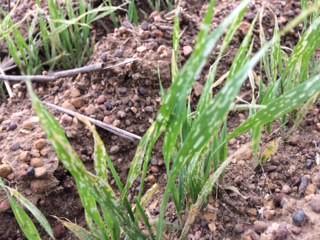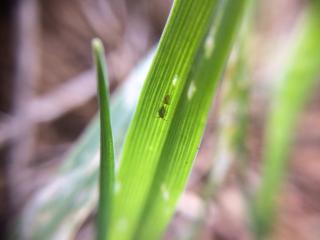Lucerne flea are continuing to damage some young crops
- Quellington
Crop protection officer Bec Swift (DPIRD) has found significant lucerne flea damage to a young (GS 10-19) barley crop this week north-east of Quellington. As indicated by the photo above, some leaves had more than 50% leaf area chewed out resulting in the typical ‘windowing’ appearance as the lucerne flea mouth parts damaged the surface leaf tissue. The crop may outgrow the damage however very high numbers of lucerne flea still exist and are likely to cause further damage so an insecticide application was recommended.
Entomologist Dusty Severtson (DPIRD) recommends that growers and consultants monitor crops for lucerne flea, especially those that are still young, to pick up cases like this which pose a risk to crop development.
For insecticide information on managing lucerne flea refer to DPIRD’s 2018 autumn/winter insecticide guide.
Growers and consultants are also reminded that if you find redlegged earth mite (RLEM) or lucerne flea may not have been controlled by seed treatments or insecticide sprays please contact Svetlana Micic, Research Officer, Albany on +61 (0)427 772 051 or Alan Lord, Technical Officer, South Perth on +61 (0)409 689 468.
For more information on lucerne flea, and potential insecticide resistance refer to DPIRD’s Diagnosing lucerne flea page and the 2018 PestFax Issue 16 article All eyes on lucerne flea and redlegged earth mite for suspected control failures.
For more information contact Dustin Severtson, Development Officer, Northam on +61 (0)8 9690 2160 or Alan Lord, Technical Officer, South Perth on +61 (0)8 9368 3758 or Svetlana Micic, Research Officer, Albany on +61 (0)8 9892 8591.


